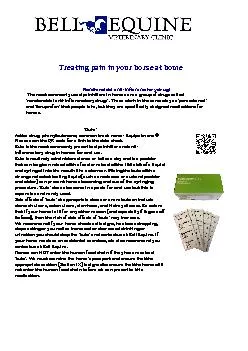/


at home Non steroidal anti inflammatory drugs The most commonly used painkillers in horses a re a group of drugs called non steroidal anti inflammatory drugs These work in the same way as ID: 831002
Download Pdf The PPT/PDF document "Treating pain in your horse" is the property of its rightful owner. Permission is granted to download and print the materials on this web site for personal, non-commercial use only, and to display it on your personal computer provided you do not modify the materials and that you retain all copyright notices contained in the materials. By downloading content from our website, you accept the terms of this agreement.
Treating pain in your horse at home
Treating pain in your horse at home Nonsteroidal anti-inflammatory drugs The most commonly used painkillers in horses are a group of drugs called ânonsteroidal anti-inflammatory drugsâ. These work in the same way as âparacetamolâ and âibruprofenâ that people take, but they are specifically designed medications for horses. âButeâ Active drug- phenylbutazone; common trade name- Equipalazone® Please scan the QR code for a link to the data sheet. Bute is the most commonly prescribed painkiller and anti-inflammatory drug in horses for oral use. Bute is routinely administered once or twice a day and is a powder that can be given mixed with a feed or mixed with a little bit of a liquid and syringed into the mouth like a wormer. Mixing the bute with a strong and sweet tasting liquid (such as molasses or custard powder and water) can prevent horses becoming anxious of the syringing procedure. âButeâ does also come in a paste for oral use but this is expensive and rarely used. Side effects of âbuteâ at appropriate doses are rare but can include stomach ulcers, colon ulcers, diarrhoea, and kidney disease. Be aware that if your horse is ill for any other reason (and especially if it goes off its food), then the risk of side effects of âbuteâ may increase. We recommend if your horse shows colic signs, has loose dropping, stops eating or you notice increased or decreased drinking or urination you should stop the âbuteâ and contact us at Bell Equine. If your horse receives an accidental overdose, we also recommend you contact us at Bell Equine. Horses can NOT enter the human food chain if they have received âbuteâ. We must examine the horseâs passport a
nd ensure that the appropriate section
nd ensure that the appropriate section (Section IX) is signed to ensure that the horse will not enter the human food chain before we can prescribe this medication. Danilon® Active drug; oxibuzone; common trade name - Danilon® Please scan the QR code for a link to the data sheet. Danilon is another commonly prescribed painkiller and anti-inflammatory drug for oral use. It comes in a granular form and can be given in feed or syringed as with âbuteâ. Danilon® can be administered once or twice daily. It is a âpro-drugâ meaning it must be metabolised by the liver into âbuteâ. It is suggested that it is less likely to cause ulcers than âbuteâ and some horses seem to find it more palatable than âbuteâ. Side effects of Danilon® at appropriate doses are also rare but are similar to âbuteâ including stomach ulcers, colon ulcers, diarrhoea, and kidney disease. We recommend if your horse shows colic signs, has loose dropping, stops eating or you notice increased or decreased drinking or urination you should stop the Danilon® and contact us at Bell Equine. If your horse receives an accidental overdose, we also recommend you contact us at Bell Equine. Horses can NOT enter the human food chain if they have received Danilon®. Metacam® Active drug; meloxicam; common trade name- Metacam® Please scan the QR code for a link to the data sheet. Metacam works in a similar way to âbuteâ and Danilon® is generally associated with less side effects than âbuteâ and Danilon®. It comes in a solution which can be added to feed or syringed into the mouth. Ideally, if mixed with feed, it should be added to a small quantity of feed prior to feeding. It is only
administered once daily in most cases.
administered once daily in most cases. Side effects of Metcam® at appropriate doses are also rare and are considered to be less likely than side effects from âbuteâ or Danilon®. As the drug works through similar pathways, side effects are similar to âbuteâ and Danilon® including stomach ulcers, colon ulcers, diarrhoea, and kidney disease. We recommend if your horse shows colic signs, has loose dropping, stops eating or you notice increased or decreased drinking or urination you should stop the Metacam® and contact us at Bell Equine. If your horse receives an accidental overdose, we also recommend you contact us at Bell Equine. Occasionally, vets at Bell Equine will choose to use other oral painkillers in your horse or may even give you injectable painkillers to give to your horse. If you have any questions about pain management in your horse, please contact us at Bell Equine. Finadyne® Active drug; flunixin meglumine; common trade name- Finadyne® Please scan the QR code for a link to the data sheet. Finadyne® also works in the same way as the other drugs in this group. It comes in a paste which can be syringed into the mouth. It can be administered once or twice daily. Side-effects of Findayne® at appropriate doses are also rare. Side-effects are similar to âbuteâ, Danilon®, and Metacam® and include stomach ulcers, colon ulcers, diarrhoea, and kidney disease. We recommend if your horse shows colic signs, has loose dropping, stops eating or you notice increased or decreased drinking or urination you should stop the Finadyne® and contact us at Bell Equine. If your horse receives an accidental overdose, we also recommend you contact us at Bell Equine